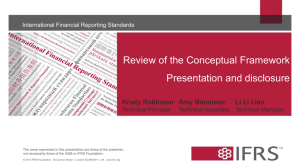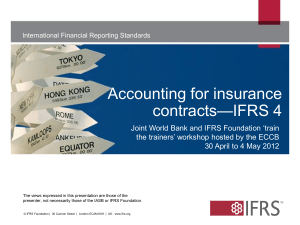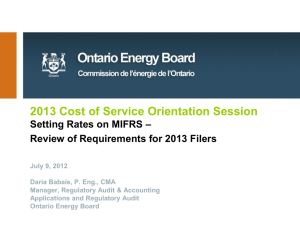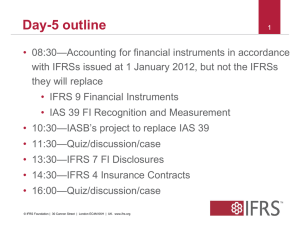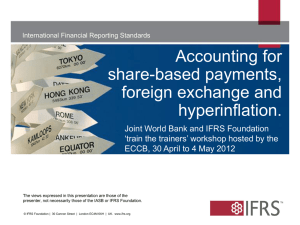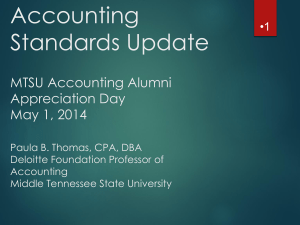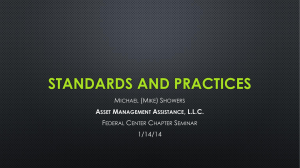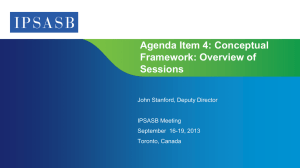Asset - IFRS
advertisement
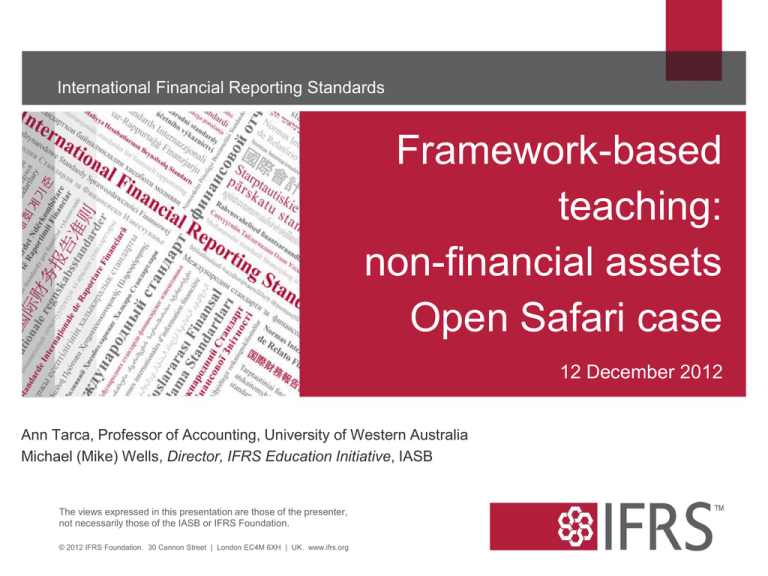
International Financial Reporting Standards Framework-based teaching: non-financial assets Open Safari case 12 December 2012 Ann Tarca, Professor of Accounting, University of Western Australia Michael (Mike) Wells, Director, IFRS Education Initiative, IASB The views expressed in this presentation are those of the presenter, not necessarily those of the IASB or IFRS Foundation. © 2012 IFRS Foundation. 30 Cannon Street | London EC4M 6XH | UK. www.ifrs.org Framework-based IFRS teaching… 2 • relate each IFRS requirements to the concepts in Conceptual Framework • explain why some IFRS requirements do not maximise those concepts (eg application of the cost constraint) Concepts Principles © IFRS Foundation. 30 Cannon Street | London EC4M 6XH | UK. www.ifrs.org Rules Framework-based IFRS teaching provides… 3 • a cohesive understanding of IFRSs – Framework facilitates consistent and logical formulation of IFRSs • a basis for judgement in applying IFRSs – Framework established the concepts that underlie the estimates, judgements and models on which IFRS financial statements are based • a basis for continuously updating IFRS knowledge and IFRS competencies © IFRS Foundation. 30 Cannon Street | London EC4M 6XH | UK. www.ifrs.org Role of the Conceptual Framework 4 • IASB uses Framework to set standards – enhances consistency across standards – enhances consistency across time as Board members change – provides benchmark for judgements • IFRS Interpretations Committee uses Framework to interpret IFRSs when there is no IFRS requirement • Preparers use Framework to develop accounting policies in the absence of specific standard – IAS 8 hierarchy © IFRS Foundation. 30 Cannon Street | London EC4M 6XH | UK. www.ifrs.org Range of IFRS classes 5 Can I use Framework-based teaching in my IFRS class? • Yes, the starting point for all IFRS teaching should be the objective of IFRS financial information and the concepts that flow logically from that objective • However, the extent of IFRS requirements taught are likely to vary by course level and to suit the objectives of the course © IFRS Foundation. 30 Cannon Street | London EC4M 6XH | UK. www.ifrs.org Focus on CA/CPA stream students 6 • Can be used at all levels of IFRS classes • However, this webcast is for CA/CPA stream • Financial reporting courses at 3 broadly defined stages along the progression to CA/CPA – Stage 1: first course – Stage 2: course mid-way to qualifying – Stage 3: immediately before qualifying • Stages are broadly defined to take account of different approaches to qualifying CA/CPAs © IFRS Foundation. 30 Cannon Street | London EC4M 6XH | UK. www.ifrs.org Suggested teaching focus Stage 1 Explain economics and relate to information needs of primary users. Teach mechanics of accounting and create awareness of estimates and other judgements. Reinforce with class discussion + tutorials. Stage 2 Explain economics and relate to information needs of primary users. Develop understanding of estimates and other judgements involved in applying IFRSs. Reinforce teaching with class discussion + tutorials exploring judgements. © 2010 IFRS Foundation. 30 Cannon Street | London EC4M 6XH | UK. www.ifrs.org 7 Stage 3 Reinforce understanding and develop competence in making the estimates and other judgements that are necessary to comply with IFRSs. Some ideas: - cross-cutting issues class discussions - advanced tutorials - integrated case studies - GAAP comparisons and improvements. Suggested assessment focus 8 Stage 1 Stage 2 Stage 3 Assess knowledge and basic understanding of: i. the main concepts ii. selected main principles iii. awareness of basic estimates and judgements Assess understanding of the estimates and other judgements in applying IFRS using fact patterns including unfamiliar items integrated with a number of IFRS topics and some accounting related disciplines (eg finance) Assess competence in making the estimates and other judgements that are necessary to apply IFRSs using integrated case studies about unfamiliar items. Isintegrated with accounting related disciplines (eg finance) Open-book examinations (ie extracts provided) Open-book examinations (The IFRS for SMEs or A Guide through IFRS) Open-book examinations (A Guide though IFRS) © 2010 IFRS Foundation. 30 Cannon Street | London EC4M 6XH | UK. www.ifrs.org The IASB’s Conceptual Framework • Framework sets out agreed concepts that underlie IFRS financial reporting – the objective of general purpose financial reporting – qualitative characteristics – elements of financial statements – recognition – measurement – presentation and disclosure Other concepts all flow from the objective © IFRS Foundation. 30 Cannon Street | London EC4M 6XH | UK. www.ifrs.org 9 Objective of financial reporting 10 Provide financial information about the reporting entity that is useful to existing and potential investors, lenders and other creditors in making decisions about providing resources to the entity © IFRS Foundation. 30 Cannon Street | London EC4M 6XH | UK. www.ifrs.org Objective of financial reporting 11 • Investors’, lenders’ and other creditors’ expectations about returns depend on their assessment of the amount, timing and uncertainty of (the prospects for) future net cash inflows to the entity. – Decisions by investors about buying, selling or holding equity and debt instruments depend on the returns that they expect from an investment in those instruments, eg dividends, principal and interest payments or market price increases. – Decisions by lenders about providing or settling loans and other forms of credit depend on the principal and interest payments or other returns that they expect. © IFRS Foundation. 30 Cannon Street | London EC4M 6XH | UK. www.ifrs.org Objective of financial reporting 12 • To assess an entity’s prospects for future net cash inflows, existing and potential investors, lenders and other creditors need information about: – the resources of the entity; – claims against the entity; and – how efficiently and effectively the entity's management and governing board have discharged their responsibilities to use the entity's resources – eg protecting the entity's resources from unfavourable effects of economic factors such as price and technological changes © IFRS Foundation. 30 Cannon Street | London EC4M 6XH | UK. www.ifrs.org Qualitative characteristics 13 • If financial information is to be useful, it must be relevant and faithfully represent what it purports to represent (ie fundamental qualities). – Financial information without both relevance and faithful representation is not useful, and it cannot be made useful by being more comparable, verifiable, timely or understandable. • The usefulness of financial information is enhanced if it is comparable, verifiable, timely and understandable (ie enhancing qualities— less critical but still highly desirable) © IFRS Foundation. 30 Cannon Street | London EC4M 6XH | UK. www.ifrs.org Pervasive constraint 14 • It is consistent with the Conceptual Framework for an IFRS requirement not to maximise the qualitative characteristics of financial information when the costs of doing so would exceed the benefits. © IFRS Foundation. 30 Cannon Street | London EC4M 6XH | UK. www.ifrs.org Examples—economics For each acquisition below choose 1 of: (a) business combination; or (b) separate asset purchase? • Freelands • Sealands • WoXy Safaris Is the expenditure on the medical research center: (a) donation to university; (b) joint arrangement with university; or (c) Open Safari’s assets and Open Safari’s research and development expenditure? © IFRS Foundation. 30 Cannon Street | London EC4M 6XH | UK. www.ifrs.org 15 Examples—economics continued 16 Is Open Safari’s interest in Sealands casino hotel: (a) passive investment; or (b) operating a casino business? Sealands holiday homes—is Open Safari: (a) selling goods; or (b) rendering construction services? © IFRS Foundation. 30 Cannon Street | London EC4M 6XH | UK. www.ifrs.org Examples—economics continued 17 Is Open Safari’s successful bid at auction in 20X9 for the black rhinos: (a) provision of a service; (b) purchase of inventory; or (c) purchase of biological asset for use in agricultural activity? Is Open Safari’s successful bid at auction in 20X9 for the white rhinos (a) provision of a service; (b) purchase of inventory; or (c) purchase of biological asset for use in agricultural activity? © IFRS Foundation. 30 Cannon Street | London EC4M 6XH | UK. www.ifrs.org Elements—concepts 18 Equity = assets less liabilities Asset Income • resource controlled • recognised increase in by the entity … asset/decrease in liability in current reporting period • expected inflow of • that result in increased economic benefits equity except… Liability Expense • present obligation … • recognised decrease in asset/increase in liability • expected outflow of in current reporting period economic benefits • that result in decreased equity except… © IFRS Foundation. 30 Cannon Street | London EC4M 6XH | UK. www.ifrs.org Examples—identifying assets 19 Are the following items Open Safari’s assets? For each item below choose 1 of: (a) yes; (b) no, no controlled resource; or (c) no, no expected FEBs. • Sealands—fish, whales etc in the sea • Freelands—pre-existing wild animals • Open Safari—assembled workforce • Animals captured on Freelands and released on Sealands • WoXy Safaris—bees • WoXy Safaris—quaggas • WoXy Safaris—elephants © IFRS Foundation. 30 Cannon Street | London EC4M 6XH | UK. www.ifrs.org Examples—identifying assets continued 20 Are the following items Open Safari’s assets? For each item below choose 1 of: (a) yes; (b) no, no controlled resource; or (c) no, no expected FEBs. • Auction 20X9—black rhino purchased • Auction 20X9—white rhino purchased • Open Safari brand • WoXy brand • Open Safari website • Contract to sell timber at fixed price (assume timber prices are falling) © IFRS Foundation. 30 Cannon Street | London EC4M 6XH | UK. www.ifrs.org International Financial Reporting Standards Asset classification (which IFRS applies?) The views expressed in this presentation are those of the presenter, not necessarily those of the IASB or IFRS Foundation © IFRS Foundation | 30 Cannon Street | London EC4M 6XH | UK | www.ifrs.org Classification concepts—assets • Different types of economic resources affect a user’s assessment of the reporting entity's prospects for future cash flows differently. 22 – some future cash flows result directly from existing economic resources (eg accounts receivable and investment property). – other cash flows result from using several resources in combination to produce and market goods or services to customers (eg PPE and intangible assets). Although those cash flows cannot be identified with individual economic resources (or claims), users of financial reports need to know the nature and amount of the resources available for use in a reporting entity’s operations. (CF.OB14) © IFRS © IFRSFoundation Foundation.| 30 30 Cannon Cannon Street Street || London London EC4M EC4M 6XH 6XH || UK. UK. www.ifrs.org www.ifrs.org Classification of assets 23 • Different assets exhibit different characteristics (nature) and can be held for a variety of uses (use) in order to generate future economic benefits • Nature and use determine the classification of assets • IFRSs defines a number of assets • For some assets significant judgement is required to determine their classification © IFRS Foundation | 30 Cannon Street | London EC4M 6XH | UK. www.ifrs.org Non-financial asset classification ASSET TYPE USE IN BUSINESS? 24 FORM OF FUTURE ECONOMIC BENEFITS Inventory (IAS 2) Sale or used in production of items for sale or in services Usually cash or other asset received in exchange PPE (IAS 16) Used in production or supply of goods or services, rental or administration (more than one period) Usually cash through sale of ‘final’ product or service Intangibles (IAS 38) Used in production or supply of goods or services Usually cash through sale of ‘final’ product or service Investment property IAS 40) Earn rentals or capital appreciation, or both Usually cash inflows independent from other assets Biological asset in agricultural activity (IAS 41) To generate returns through managing the biological transformation of biological assets for sale, conversion into agricultural produce or progeny Usually cash or other asset received in exchange for harvested products or sale of progeny © IFRS Foundation | 30 Cannon Street | London EC4M 6XH | UK. www.ifrs.org Examples—asset classification 25 Which IFRS classification of asset? For each item below choose 1 of: (a) inventory; (b) PPE; (c) intangible; (d) investment property; (e) biological asset in agricultural activity; or (f) financial asset • • • • • Freelands—land WoXy—land planted with plantation Sealands—land WoXy—bees WoXy—quaggas © IFRS Foundation. 30 Cannon Street | London EC4M 6XH | UK. www.ifrs.org Examples—asset classification continued Which IFRS classification of asset? For each item below choose 1 of: (a) inventory; (b)PPE; (c) intangible; (d) investment property; (e)biological asset in agricultural activity; or (f)financial asset • Sealands—introduced caged animals • Sealands—introduced fenced animals • WoXy + Freelands—tourist carrying elephants and horses • purchased customer list © IFRS Foundation. 30 Cannon Street | London EC4M 6XH | UK. www.ifrs.org 26 Judgements and estimates (IAS 40) 27 • It can be difficult to determine whether particular biological assets are engaged in agricultural activity and therefore in the scope of IAS 41—eg the animals of some zoos. • Sometimes it is difficult to identify investment property (IAS 40). In such cases an entity develops criteria so that it can exercise that judgement consistently • eg, owner of a hotel transfers some responsibilities to third parties under a management contract (PPE or investment property?) © IFRS Foundation | 30 Cannon Street | London EC4M 6XH | UK. www.ifrs.org International Financial Reporting Standards Asset recognition concepts The views expressed in this presentation are those of the presenter, not necessarily those of the IASB or IFRS Foundation © IFRS Foundation | 30 Cannon Street | London EC4M 6XH | UK | www.ifrs.org Asset recognition concepts 29 An asset is recognised when: • it is probable that any future economic benefit associated with the item will flow to the entity; and • the item has a cost or value that can be measured with reliability. For some items that satisfy the definition of an asset, significant judgement is required to evaluate whether such items satisfy the recognition criteria. Individual IFRSs provide principles and application guidance. © IFRS Foundation | 30 Cannon Street | London EC4M 6XH | UK. www.ifrs.org Recognition questions 30 What does probable mean? The meaning of probable is determined at the standards level. Therefore, inconsistent use across IFRSs What does measure reliably mean? To a large extent, financial reports are based on estimates, judgements and models rather than exact depictions. ©©IFRS Foundation | 30 IFRS Foundation. 30Cannon CannonStreet Street| |London LondonEC4M EC4M6XH 6XH| |UK. UK.www.ifrs.org www.ifrs.org Recognition of development cost (IAS 38) 31 An intangible asset arising from the development phase of an internal project must be recognised if, and only if, an entity can demonstrate all of the following: a. the technical feasibility of completing the intangible asset so that it will be available for use or sale. b. its intention to complete the intangible asset and use or sell it. c. its ability to use or sell the intangible asset. d. how the intangible asset will generate probable future economic benefits. Among other things, the entity can demonstrate the existence of a market for the output of the intangible asset or the intangible asset itself or, if it is to be used internally, the usefulness of the intangible asset. e. the availability of adequate technical, financial and other resources to complete the development and to use or sell the intangible asset. f. its ability to measure reliably the expenditure attributable to the intangible asset during its development. © IFRS Foundation | 30 Cannon Street | London EC4M 6XH | UK. www.ifrs.org Examples—recognition 32 Recognise the asset? For each item below choose 1 of: (a) yes; (b) no, FEBs not probable; or (c) no, cannot measure with reliability • Open Safari brand • WoXy brand • Goodwill on acquiring WoXy • Expenditures to restore WoXy brand • Sealands casino licence (government grant) • Medical research centre—PPE • Medical research centre—research expenditure • Medical research centre—development expenditure • Contract to sell timber at a fixed price at specified future date (timber prices falling) ©©IFRS Foundation | 30 IFRS Foundation. 30Cannon CannonStreet Street| |London LondonEC4M EC4M6XH 6XH| |UK. UK.www.ifrs.org www.ifrs.org Unit of account 33 • The concept—unit of account is the level at which an asset is aggregated or disaggregated for recognition purposes. • Most IFRS do not prescribe the unit of account therefore judgement is required in applying recognition criteria to an entity’s specific circumstances. © IFRS Foundation | 30 Cannon Street | London EC4M 6XH | UK. www.ifrs.org Examples—unit of account How many separate items for recognition? • WoXy—elephants (a)‘herd’ as a whole (b)individual elephants • WoXy—bees (a)all 500 swarms collectively (b)each swarm (c) individual bees © IFRS Foundation. 30 Cannon Street | London EC4M 6XH | UK. www.ifrs.org 34 Examples—unit of account continued How many separate items for recognition? • Sealands—unsold beachfront homes (a)all unsold homes collectively (b)each unsold home separately (c) each unsold home as two separate items—roofs separate from main structure © IFRS Foundation. 30 Cannon Street | London EC4M 6XH | UK. www.ifrs.org 35 International Financial Reporting Standards Measurement The views expressed in this presentation are those of the presenter, not necessarily those of the IASB or IFRS Foundation © IFRS Foundation | 30 Cannon Street | London EC4M 6XH | UK. www.ifrs.org Measurement ‘concepts’ 37 • Measurement is the process of determining monetary amounts at which elements are recognised and carried. (CF.4.54) • To a large extent, financial reports are based on estimates, judgements and models rather than exact depictions. – The Conceptual Framework establishes the concepts that underlie those estimates, judgements and models (CF.OB11) ©©IFRS | 30 IFRSFoundation Foundation. 30Cannon CannonStreet Street | | London LondonEC4M EC4M6XH 6XH | | UK. UK. www.ifrs.org www.ifrs.org Measurement ‘concepts’ continued 38 • Measurement part of Conceptual Framework is weak • A number of different measurement bases are employed to different degrees and in varying combinations in financial statements, including – – – – historical cost current cost realisable (settlement) value present value (CF.4.55) • IASB guided by objective and qualitative characteristics when specifying measurements. ©©IFRS Foundation | 3030 Cannon Street EC4M 6XH IFRS Foundation. Cannon Street| London | London EC4M 6XH| UK. | UK.www.ifrs.org www.ifrs.org Measurement ‘concepts’ continued 39 • Historical cost ‘concept’: Assets are recorded at the amount of cash or cash equivalents paid or the fair value of the consideration given to acquire them at the time of their acquisition. • Fair value concept: the price that would be received to sell an asset (exit price) in an orderly transaction (not a forced sale) between market participants (market-based view) at the measurement date (current price). © IFRS © IFRSFoundation Foundation.| 30 30 Cannon Cannon Street Street || London London EC4M EC4M 6XH 6XH || UK. UK. www.ifrs.org www.ifrs.org ASSET TYPE MEASUREMENT AT INITIAL RECOGNITION COST MODEL BASIS OF IMPAIRMENT 40 TEST IAS 2 Inventory Cost of purchase and/or conversion costs and costs to get the item to the location and condition for sale Cost unless impaired Lower of cost (initial recognition) and net realisable value IAS 16 Property, Plant and Equipment Purchase costs + construction costs + costs to bring to the location and condition necessary to be capable of operating in the manner intended by management. Accounting policy choice: cost less accumulated depreciation and impairment, if any Compare carrying amount to recoverable amount. IAS 38 Intangibles Assets Purchase costs + development costs + costs to bring to the location and condition necessary to be capable of operating as intended by management Accounting policy choice: cost less accumulated amortisation (unless indefinite life asset) and amortisation, if any IAS 40 Investment Property Cost including transaction costs Accounting policy choice: cost less accumulated depreciation (unless land) and impairment (if any) IFRS 9 Financial Fair value © IFRS Foundation. 30 Cannon Street | London EC4M 6XH Instruments | UK. www.iasb.org For particular business models amortised cost Recoverable amount is greater of value in use and fair value less disposal costs (IAS 36) IAS 39 specifies impairment rules ASSET TYPE MEASUREMENT AT INITIAL RECOGNITION MODEL BASED ON FAIR VALUE IFRS 9 Financial Instruments Fair value For specified financial assets and for particular business models: fair value IAS 16 Property, Plant and Equipment Purchase costs + construction costs + costs to bring to the location and condition necessary to be capable of operating in the manner intended by management. Accounting policy choice: revaluation model IAS 38 Intangible Assets Purchase costs + development costs + costs to bring to the location and condition necessary to be capable of operating as intended by management Accounting policy choice: revaluation model IAS 40 Investment Property Cost including transaction costs Accounting policy choice: fair value IAS 41 Agriculture Fair value less costs to sell Fair value less costs to sell © IFRS Foundation. 30 Cannon Street | London EC4M 6XH | UK. www.iasb.org BASIS OF IMPAIRMENT TEST 41 Compare carrying amount to recoverable amount. Recoverable amount is greater of value in use and fair value less disposal costs (IAS 36) Examples— measurement ‘economics’ Which currency is Open Safari’s functional currency? Choose one of (a) to (f) below: (a) Euro (b) British pound (c) South African rand (d) Africanian Zollar (e) US dollar (f) Any currency that Open Safari chooses © IFRS Foundation. 30 Cannon Street | London EC4M 6XH | UK. www.ifrs.org 42 Examples— measurement ‘economics’ continued 43 • Why did the IASB conclude that it would be highly unlikely that an entity can justify a change in accounting policy for investment property from the fair value model to the cost model? • Why did the IASB conclude that fair value measurement was most appropriate measurement attribute for biological assets in agricultural activity? • What is the ‘economics’ of depreciation? © IFRS Foundation. 30 Cannon Street | London EC4M 6XH | UK. www.ifrs.org Example—measurement at initial recognition 44 At what amount are the animals released on Sealands (captured on Freelands) measured when first recognised? (a) nil (b) expenditure on capture (c) expenditure on relocation (d) expenditure on capture and relocation (e) capture date fair value (f) capture date fair value less estimated costs to sell © IFRS Foundation. 30 Cannon Street | London EC4M 6XH | UK. www.ifrs.org Example—depreciation 45 Residual value of spacecraft at 31/12/20Y0? (a) (b) (c) (d) nil CU10 million CU10 million less expected costs of disposal amount would get on 31/12/20Y0 less estimated costs of disposal, if already 5 years old and in the condition expected at the end of 20Y5. (e) amount would get on 31/12/20Y0 less estimated costs of disposal, if already flown 100 flights and in condition expected after 100 flights. (f) present value of CU10 million less estimated costs of disposal. © IFRS Foundation. 30 Cannon Street | London EC4M 6XH | UK. www.ifrs.org Example—depreciation continued 46 Must any components of the spacecraft be depreciated separately? (a) no (b) yes, the inspection component must be depreciated separately from the other components of the spacecraft (ie 2 components). (c) yes, the inspection component and the soft furnishings component must each be depreciated separately from the other components (ie 3 components). © IFRS Foundation. 30 Cannon Street | London EC4M 6XH | UK. www.ifrs.org Example—depreciation continued 47 Which depreciation method must be used for the spacecraft? (a) management choose depreciation method. (b) straight line method for both the inspection component and other component. (c) units of production method for both the inspection component and other component. (d) revenue-based depreciation for both the inspection component and other component. (e) straight line for the inspection component and units of production (based on the number of flights) for other component. © IFRS Foundation. 30 Cannon Street | London EC4M 6XH | UK. www.ifrs.org Example—depreciation continued At 31/12/20Y0 spacecraft’s useful life is? (a) (b) (c) (d) (e) 100 voyages for entire spacecraft. 150 voyages for entire spacecraft. 4 years for entire spacecraft. 5 years for entire spacecraft. service component = 2 years and other component = 150 voyages. (f) service component = 2 years and other component = 100 voyages. (g) service component = 2 years and other component = 4 years. © IFRS Foundation. 30 Cannon Street | London EC4M 6XH | UK. www.ifrs.org 48 Examples—measurement after recognition 49 How to measure fair value of 1. Sealands casino building? 2. WoXy plantation? 3. animals (eg buffaloes and rhinos on Sealands)? © IFRS Foundation. 30 Cannon Street | London EC4M 6XH | UK. www.ifrs.org Judgements and estimates, cost 50 • Cost of some items includes significant estimates • what is cost? • costs allocations • cost of dismantling, removal, restoration • costs of self constructed assets • Depreciation represents the consumption of the assets service potential in the period. Measuring requires: • identifying significant components to be depreciated separately • estimating useful life and residual value • identifying the depreciation method that reflects most closely the consumption of the service potential of the item of PPE • Determining the classes of assets (eg PPE) © IFRS Foundation | 30 Cannon Street | London EC4M 6XH | UK. www.ifrs.org Judgements and estimates, fair value 51 • When using the most recent market transaction price to measure fair value: identifying the most recent market transaction price and evaluating whether economic circumstances have changed significantly. • When using market prices for similar assets: adjusting the prices to reflect differences. • When using sector benchmarks (eg the value of cattle expressed per kilogram of meat): adjusting to reflect differences. • When using DCF model: estimating the expected future net cash inflows and the discount rate. © IFRS Foundation | 30 Cannon Street | London EC4M 6XH | UK. www.ifrs.org International Financial Reporting Standards Derecognition The views expressed in this presentation are those of the presenter, not necessarily those of the IASB or IFRS Foundation Derecognition 53 • Derecognition occurs when a recognised item is removed from the statement of financial position • There is no explicit concept for derecognition in the Conceptual Framework. Consequently: • derecognition requirements are specified at the Standards level • inconsistencies exist between the derecognition requirements of different IFRSs • derecognition does not necessarily coincide with no longer meeting the requirements specified for recognition © IFRS Foundation. 30 Cannon Street | London EC4M 6XH | UK. www.ifrs.org Examples—derecognition 54 • When does Open Safari derecognise the elephant bull released onto Freelands? (a)when the bull is released (b)when the bull first walks off Freelands (c)when the bull dies (d)never © IFRS Foundation. 30 Cannon Street | London EC4M 6XH | UK. www.ifrs.org International Financial Reporting Standards Presentation and disclosure The views expressed in this presentation are those of the presenter, not necessarily those of the IASB or IFRS Foundation Presentation and disclosure ‘concepts’ 56 • Objective of financial reporting • Financial statements portray financial effects of transactions and events by: – grouping into broad classes (the elements, eg asset) – sub-classify elements (eg assets sub-classified by their nature or function in the business) • IAS 1 – need not provide a specific disclosure if the information is not material – application of IFRSs with additional disclosures when necessary results in a fair presentation (faithful representation of transactions, events and conditions) – do not offset assets & liabilities or income & expenses © IFRS © IFRSFoundation Foundation.| 30 30 Cannon Cannon Street Street || London London EC4M EC4M 6XH 6XH || UK. UK. www.ifrs.org www.ifrs.org Examples— measurement ‘economics’ Which currency is Open Safari’s presentation currency? Choose one of (a) to (f) below: (a) Euro (b) British pound (c) South African rand (d) Africanian Zollar (e) US dollar (f) Any currency that Open Safari chooses © IFRS Foundation. 30 Cannon Street | London EC4M 6XH | UK. www.ifrs.org 57 Questions or comments? Expressions of individual views by members of the IASB and its staff are encouraged. The views expressed in this presentation are those of the presenter. Official position of the IASB on accounting matters are determined only after extensive due process and deliberation. © IFRS Foundation | 30 Cannon Street | London EC4M 6XH | UK. www.ifrs.org © 2012 IFRS Foundation. 30 Cannon Street | London EC4M 6XH | UK. www.ifrs.org 58 Questions or comments? Non financial assets - does it cover leased assets? © IFRS Foundation | 30 Cannon Street | London EC4M 6XH | UK. www.ifrs.org © 2012 IFRS Foundation. 30 Cannon Street | London EC4M 6XH | UK. www.ifrs.org 59 Questions or comments? Should insurance in transit be capitalized to PP&E as many believe it is not an assets cost hence should be expensed but other thought it is transaction cost hence capitalized as IAS 16 not prohibit capitalization of transaction cost © IFRS Foundation | 30 Cannon Street | London EC4M 6XH | UK. www.ifrs.org © 2012 IFRS Foundation. 30 Cannon Street | London EC4M 6XH | UK. www.ifrs.org 60 Questions or comments? In IAS 16 unit of account is not prescribed. In absence of explicit UOA what should be the guiding principle for determination of UOA whether component concept could be utilized for UOA? © IFRS Foundation | 30 Cannon Street | London EC4M 6XH | UK. www.ifrs.org © 2012 IFRS Foundation. 30 Cannon Street | London EC4M 6XH | UK. www.ifrs.org 61 Questions or comments? Can I upload the case on the website of the school for students to download and print for teaching purpose? © IFRS Foundation | 30 Cannon Street | London EC4M 6XH | UK. www.ifrs.org © 2012 IFRS Foundation. 30 Cannon Street | London EC4M 6XH | UK. www.ifrs.org 62 Questions or comments? can you explain "the concept of economics of depreciation" with reference to SME © IFRS Foundation | 30 Cannon Street | London EC4M 6XH | UK. www.ifrs.org © 2012 IFRS Foundation. 30 Cannon Street | London EC4M 6XH | UK. www.ifrs.org 63 Questions or comments? What do you judge the functional currency of Open Safari to be? What factors of IAS 21 did you consider? © IFRS Foundation | 30 Cannon Street | London EC4M 6XH | UK. www.ifrs.org © 2012 IFRS Foundation. 30 Cannon Street | London EC4M 6XH | UK. www.ifrs.org 64 Questions or comments? I get the sense that you would encourage more discussion-based assessments rather than number-based assessments that traditional accounting courses use. Would this be correct? © IFRS Foundation | 30 Cannon Street | London EC4M 6XH | UK. www.ifrs.org © 2012 IFRS Foundation. 30 Cannon Street | London EC4M 6XH | UK. www.ifrs.org 65 Questions or comments? Thankyou © IFRS Foundation | 30 Cannon Street | London EC4M 6XH | UK. www.ifrs.org © 2012 IFRS Foundation. 30 Cannon Street | London EC4M 6XH | UK. www.ifrs.org 66
